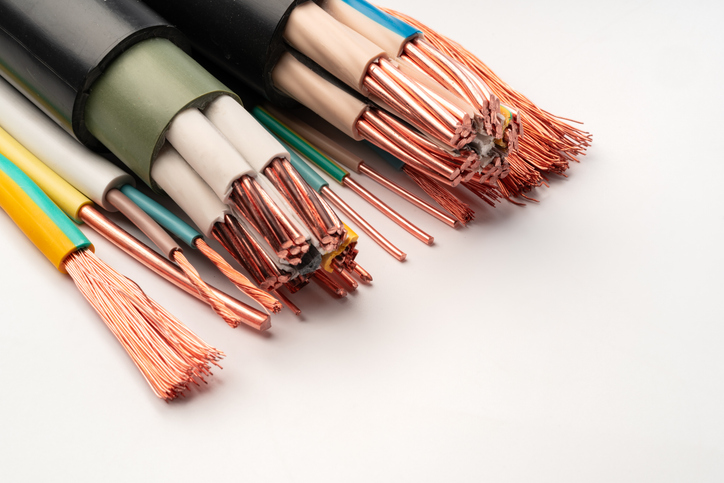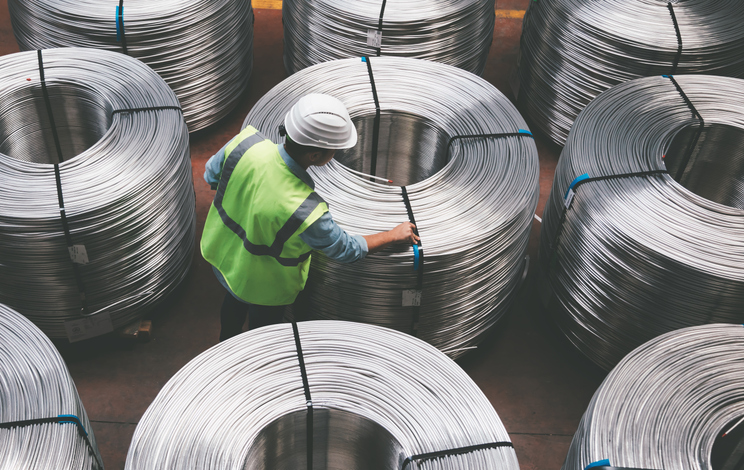Portable Cord Guide
What is Portable Cord?
Portable cord, also referred to as flexible cord, extension cord or portable cordage, is a multi-conductor cable used for temporary electrical connections. Flexibility is a key feature, as portable cord applications often involve moving equipment like power tools or appliances. Portable cord is used for a variety of applications, from industrial equipment to home extension cords. They also can be made for environmental conditions like water, oil or extreme temperatures. These different applications are noted using a system of letter code designations.

Portable Cord Letter Codes
Portable cord attributes are designated with a system of letter codes that are defined by UL. These codes help understand jacket and insulation, service voltage, duty and heat/oil resistance. These codes can be broken down using the table below.
Portable Cord Letter Code Anatomy
| Category | Letter Code | Definition |
|---|---|---|
| Service | S | Severe Service (600V) |
| SJ | Junior Service (300V) | |
| Jacket | E | Elastomer |
| T | Thermoplastic (Unless first letter of code - then it designates tinsel cord) | |
| O | Oil resistant jacket | |
| OO | Oil resistant jacket and insulation | |
| Weather Resistance | W | Weather resistant |
| Application | V | Vacuum cord |
UL CORD CONSTRUCTION AND RATINGS
Knowing how to define each letter in a portable cord code is one thing, but it doesn’t necessarily make it easy to find the right cord for your application. Using the table below, we’ve broken down the specifics of most types of UL rated portable cord.
| Cord Type* | Description | AWG Size Range | Number of Conductors | Conductor Insulation | Jacket** | Temperature Rating*** | Voltage Rating | |
|---|---|---|---|---|---|---|---|---|
| Std. | Other | |||||||
| TPT | Tinsel Parallel Thermoplastic | 27 (Tinsel) | 2 | 0.030 Plastic | - | 60 | - | 250 |
| SP-1 | - | 18 | 2 or 31 | 0.030 Rubber | - | 60 | - | 300 |
| SPT-1 | Service Parallel Thermoplastic - 1/64” Insulation | 18 | 2 or 31 | 0.045 Rubber |
- | 60 | 75, 90, 105 | 300 |
| SP-2 | - | 18-16 | 2 or 31 | 0.045 Rubber | - | 60 | - | 300 |
| SPT-2 | Service Parallel Thermoplastic - 2/64” Insulation | 18-16 | 2 or 31 | 0.045 Plastic | - | 60 | 75, 90, 105 | 300 |
| SP-3 | - | 18-12 | 2 or 31 | 0.060 Rubber2 | - | 60 | - | 300 |
| SPT-3 | Service Parallel Thermoplastic - 3/64” Insulation | 18-10 | 2 or 31 | 0.060 Plastic2 | - | 60 | 75, 90, 105 | 300 |
| TS | Tinsel Service | 27 (Tinsel) | 2 or 31 | 0.015 Rubber | 0.031 Rubber | 60 | - | 125 |
| TST | Tinsel Service Thermoplastic | 27 (Tinsel) | 2 | 0.015 Plastic | 0.031 Plastic | 60 | - | 125 |
| SV | Service Vacuum | 18 | 2 or 31 | 0.015 Rubber | 0.030 Rubber | 60 | 75, 90 | 300 |
| SVE | Service Vacuum Elastomer | 18 | 2 or 31 | 0.015 Elastomer | 0.030 Elastomer | 105 | - | 300 |
| SVEO | SVE with Oil-Resistant Jacket | 18-17 | 2 or 31 | 0.015 Elastomer | 0.030 Elastomer | 105 | - | 300 |
| SVO | Service Vacuum Oil-Resistant Jacket | 18 | 2 or 31 | 0.015 Rubber | 0.030 Neoprene~ | 60 | 75, 90 | 300 |
| SVT | Service Vacuum Thermoplastic | 18-17 | 2 or 31 | 0.015 Plastic | 0.030 Plastic | 60 | 75, 90, 105 | 300 |
| SVTO | SVT with Oil-Resistant Jacket | 18-17 | 2 or 31 | 0.015 Plastic | 0.030 Plastic | 60 | 75, 90, 105 | 300 |
| SJ | Service Junior | 18-10 | 2, 3, 4 | 0.030 Rubber3 | 0.030 Rubber2 | 60 | 75, 90 | 300 |
| SJE | Service Junior Elastomer | 18-10 | 2, 3, 4, 5 | 0.030 Elastomer2 | 0.030 Elastomer2 | 105 | - | 300 |
| SJEO | SJE with Oil-Resistant Jacket | 18-10 | 2, 3, 4, 5 | 0.030 Elastomer2 | 0.030 Elastomer2 | 105 | - | 300 |
| SJO | SJ with Oil-Resistant Jacket | 18-10 | 2, 3, 4 | 0.030 Rubber3 | 0.030 Neoprene-3 | 60 | 75, 90, 105 | 300 |
| SJOOW | SJO with Oil-Resistant Insulation & Jacket,
Indoor/Outdoor use | 18-10 | 2, 3, 4 | 0.030 Rubber3 | 0.030 Neoprene-3 | 60 | 75, 90, 105 | 300 |
| SJT | Service Junior Thermoplastic | 18-10 | 2, 3, 4 | 0.030 Plastic3 | 0.030 Plastic3 | 60 | 75, 90, 105 | 300 |
| SJTO | SJT with Oil-Resistant Jacket | 18-10 | 2, 3, 4 | 0.030 Plastic3 | 0.030 Plastic3 | 60 | 75, 90, 105 | 300 |
| S | Service | 18-2 | 2 or more | 0.030 Rubber2 | 0.060 Rubber2 | 60 | 75, 90 | 600 |
| SE | Service Elastomer | 18-2 | 2 or more | 0.030 Elastomer2 | 0.060 Elastomer2 | 105 | - | 600 |
| SEO | SE with Oil-Resistant Jacket | 18-2 | 2 or more | 0.030 Elastomer2 | 0.060 Elastomer2 | 105 | - | 600 |
| SO | Service with Oil-Resistant Jacket | 18-2 | 2 or more | 0.030 Rubber2 | 0.060 Neoprene-2 | 60 | 75, 90 | 600 |
| SOOW | SO with Oil-Resistant Insulation & Jacket,
Indoor/Outdoor use | 18-2 | 2 or more | 0.030 Rubber2 | 0.060 Neoprene-2 | 60 | 75, 90 | 600 |
| ST | Service Thermoplastic | 18-2 | 2 or more | 0.030 Plastic2 | 0.060 Plastic2 | 60 | 75, 90, 105 | 600 |
| STO | ST with Oil-Resistant Jacket | 18-2 | 2 or more | 0.030 Plastic2 | 0.060 Plastic2 | 60 | 75, 90, 105 | 600 |
| STOOW | STO with Oil-Resistant Insulation & Jacket,
Indoor/Outdoor use | 18-2 | 2 or more | 0.030 Plastic2 | 0.060 Plastic2 | 60 | 75, 90, 105 | 600 |
| HPN | Heater Parallel Neoprene | 18-2 | 2 or 31 | 0.045 Neoprene | - | 90 | 105 | 300 |
| HSJ | Heater Service Junior | 18-2 | 2, 3, 4 | 0.030 Neoprene2 | 0.030 Rubber2 | 90 | - | 300 |
| HSJO | HSJ with Oil-Resistant Jacket | 18-2 | 2, 3, 4 | 0.030 Neoprene2 | 0.030 Neoprene-2 | 90 | - | 300 |
| HS | Heater Service | 14-12 | 2, 3, 4 | 0.045 Neoprene2 | 0.060 Rubber2 | 90 | - | 300 |
| HSO | HS with Oil-Resistant Jacket | 14-12 | 2, 3, 4 | 0.045 Neoprene2 | 0.060 Neoprene-2 | 90 | - | 300 |
* Types SVO, SVTO, SJO, SJOOW, SJTO, SO, SOOW, STO HSJO and HSO have jackets which are also recognized for oil resistance at maximum temperature of 60C. Types SJ, SJO, SJT, SJTO, S, SO, ST and STO may also be printed as “OOW” infering an oil resistant insulation and an oil resistant and moisture resistant jacket. Acceptable for indoor/outdoor use. 3-wire SJT may be made in special low-leakage constructions for medical equipment cords.
** Where no jacket is shown, the construction is integral or flat style with insulation also serving as jacket.
* Types SVO, SVTO, SJO, SJOOW, SJTO, SO, SOOW, STO HSJO and HSO have jackets which are also recognized for oil resistance at maximum temperature of 60C. Types SJ, SJO, SJT, SJTO, S, SO, ST and STO may also be printed as “OOW” infering an oil resistant insulation and an oil resistant and moisture resistant jacket. Acceptable for indoor/outdoor use. 3-wire SJT may be made in special low-leakage constructions for medical equipment cords.
** Where no jacket is shown, the construction is integral or flat style with insulation also serving as jacket.
3 Insulation and jacket thickness depend on cordage size. No. 12 AWG requires .030” conductor insulation thickness and .045” jacket thickness. No. 10 AWG requires .045” conductor insulation thickness and .060” jacket thickness.
Chlorosulfonated polyethylene and other UL Listed materials may be used as jacketing material for such cordage as SVO, SJO, SO and HPN to provide oil resistance and/or colors with excellent stability in all shades.
NOTE Types TPT, SPT-1, SPT-2, SPT-3, HPN (two conductors only) and SVO, SVT, SJO, SJT, SO and ST may be made in retractile form.
The term Elastomer refers to thermoplastic elastomer.
Related Resources

Building Wire Guide - THHN vs Other
In the world of building wire, there are several common choices available that at first appear quite similar. Learn More
How to Choose the Right Wire or Cable
In selecting a wire or cable for an application, several factors should be considered. Learn More
Industry Organizations & Standards
Understanding industry organizations and standards is essential for anyone involved in manufacturing, installation, or regulatory compliance.Read More


